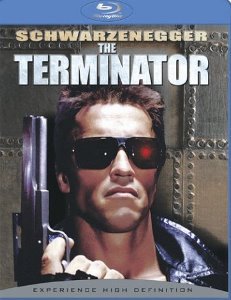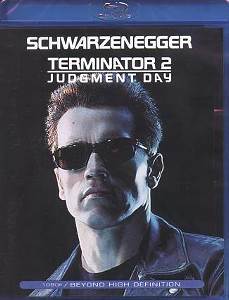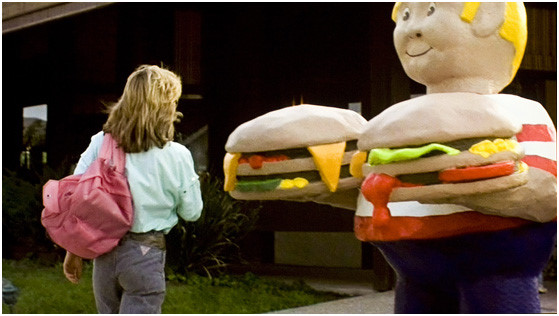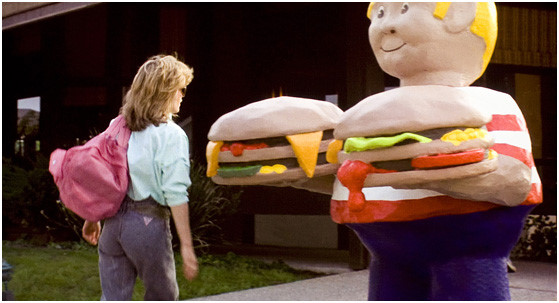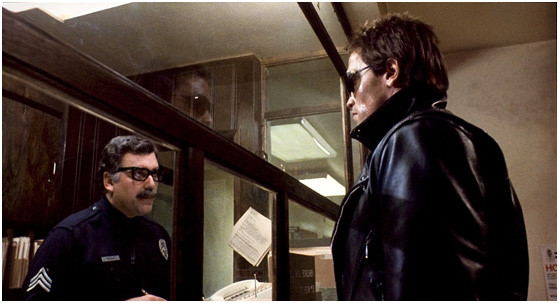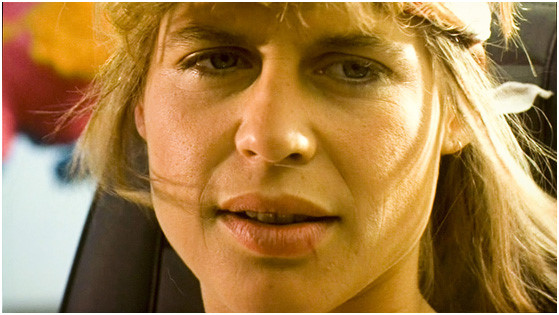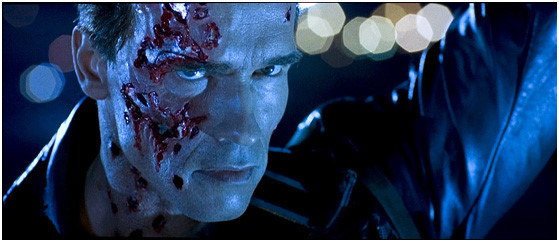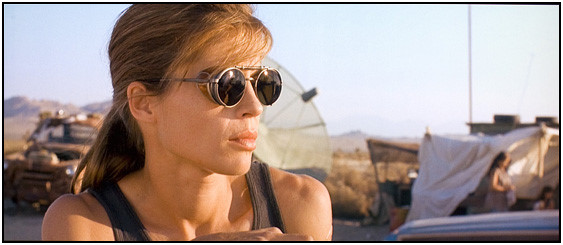The Terminator BRD
Terminator 2: Judgment Day BRD
The Specs:
The Terminator
Directed by James Cameron
1984
Review by Leonard Norwitz
Studio: MGM (USA)
Video:
Aspect ratio: 1.85:1
Feature film: 1080p / MPEG-2
108 minutes
Supplements: 480i / MPEG-2
1 disc: BD-25 single-layer
Audio:
English PCM 5.1 Surround
English DD 5.1 Surround
French DD 5.1 Surround
Subtitles:
English SDH, English, Spanish, Chinese, Korean, Portuguese, and Thai
Extras
• Featurette: "Creating the Terminator: Visual Effects & Music"
• Featurette: "Terminator: A Retrospective"
• Deleted scenes
16 chapters
Standard Blu-ray case.
Release Date: June 20, 2006
Terminator 2: Judgment Day
Directed by James Cameron
1991
Review by Leonard Norwitz
Studio: Lionsgate (USA)
Video:
Aspect ratio: 2.35:1
Feature film: 1080p / MPEG-2
137 minutes (original theatrical version)
Supplements: 480i / MPEG-2
1 disc: BD-25 single-layer
Audio:
English DTS-ES Matrixed 5.1 Surround
English DD 5.1 Surround EX
Subtitles:
English &Spanish, selectable
Extras:
• Two commentaries
xx chapters
Standard Blu-ray case
Release Date: June 27, 2006
The Terminators 1 & 2
Comparisons are not only what DVDBeaver is all about, but it also appears to be in our blood. We can't seem to escape pairing the nearly alike or related. Sequels have a way of promoting divided loyalties, beginning way back with The Thin Man and After the Thin Man. The sequel craze got a serious nudge with The Godfather/The Godfather Part, 2, Alien/Aliens, and the first three Star Wars movies. We even compare the original and "Special Editions" of Episodes IV-VI, and the two trilogies of Episodes I-III and IV-VI. There are exceptions where preference consensus is clear: the first two Star Trek movies and the first two Indiana Jones movies are prime examples. Remakes also make ready grist for the comparison mill: Hitchcock's 1934 and 1955 versions of The Man Who Knew Too Much; the 1956 Invasion of the Body Snatchers and Phil Kaufman's 1978 remake; or the 1937, 1954 and 1976 versions of A Star is Born, plus the "original" 1932 movie titled What Price Hollywood. The many James Bond movies are in a class by themselves perhaps, but still generate enthusiastic comparisons.
Sci-fi and fantasy fans often find themselves in opposed and seemingly irreconcilable camps: The first and second Terminator movies are no exception. These (and the ill-considered Terminator 3) were both directed and co-written by James Cameron. The first film, back in 1984, pretty much put Cameron on the map as a director. His extroverted follow up to Ridley Scott's implosive Alien two years later proved his ability to handle technicals, which led by way of The Abyss to Terminator 2: Judgment Day. Only six years after the original, T2 looks like it's from a different page of cinematic history. It's amazing what a budget of $100,000,000 can do for you as compared to the original's $6,400,000.
The Terminator, for all its sci-fi underpinnings, is a story with fairly easy to understand characters: One wants to kill, another wants to stay alive, yet another wants to keep the second from being killed. The time travel element keeps the sci-fi nerds interested; Schwarzenegger's relentless Terminator appeals to the latency age boy in all of us; and the affair between Sarah and her protector works well for the romantics – all woven together in a consistent narrative style. Not so for T2. The target audience for T2 is a quite different: broader, younger, and very much into video games. The Cyberdyne subplot appeals to the conspiratorialists (lots of gaming opportunities there). The romantic angle is now remapped as a buddy movie between Arnold's new Terminator and Sarah's adolescent son. But the big difference is that there is now a complex family dynamic about a boy who never knew his father and who befriends, as it were, the thing that killed him. Add to that the boy is now in a foster home separated from his mother, who's been in a mental hospital for the past several years. No chance Cameron could be taken to task for repeating himself. He even brings in a second terminator, more indestructible than the first: lighter, faster, stronger, and damn near infinitely reassembliable.
The technicals in T2 were, in its day, jaw-dropping, with its near-seamless transformation of physical states from one character to another, and from the inanimate to the animate, as in when the T-1000, in its signature move, absorbs and recomposes bits of itself into the mercurial metal that is himself. The movie's longer length works in more threads, more characters and massive amounts of effects, woven into the story without waste. There is more varied vehicular action in the sequel. They are well choreographed – both in terms of thrills and to support certain elements of the story: namely the growing trust between Arnold and the boy and Sarah, and to demonstrate additional capabilities of the T-1000. John Connor's backstory takes screen time to set up, and some may feel that the pace drags almost from the outset as it accommodates for how his past will figure into the rest of the story. The original movie, by comparison, is tight and focused, where even the love story angle is not dwelt on long before Arnold returns once again.
The two movies are sufficiently different from each other that one or the other can appeal to whatever suits our fancy at the moment. But in absolute terms, I feel the first one is the better film. Its tight focus on just three characters keeps the drama and the action moving along. In T2 Cameron's ploy to make the familiar Terminator John's protector instead of his assassin is a clever idea, and it becomes a source of most of the film's humor. It's that layer that is happily missing from the original, concentrating our attention on the suspense of pursuit. The only time the first movie reaches for a laugh, it falls flat, as in the scene when we see Sarah as a fumbling waitress. It is not really necessary to demonstrate that the future mother of the leader of the free world is all thumbs.
Judgment Day, on the other hand, intends to be a family film; but its appeal to a broader audience is also its liability. If you think about it, there isn't really all that much suspense in T2. Once we sort out The Terminator's mission, we are on pause while John and the machine bond. The bonding is nicely, if a little too cutely, executed: kind of Buffy-light. My feeling is that, after the first encounter between the two Terminators, if it weren't for the episode around Miles Dyson (played with a humanity lacking elsewhere by Joe Morton), there isn't much dramatic tension here. The affecting scene where Myles restrains the detonator from making contact seems almost out of place. The final scene means to be equally touching, though I found it more contrived.
![]()
The Terminator
The Score Card
The Movie : 8
The original Terminator movie made more of the time-travel-to-alter-the-future angle than the sequel. In the future War of the Humans Against the Machines, the Machines have lost the edge, so they send a Terminator to the past to assassinate the mother of John Connor, the human resistance's most important leader. To counter this move, Connor sends a human back in time to protect his mother. Not a fair fight, really. The simple reason why the first Terminator movie is so much more suspenseful than the sequel is that Sarah's protector is human, whereas in T2, the protector is just another, if less advanced, Terminator. In fact, Michael Biehn merely tries to outrun and outsmart Schwarzenegger. This was Biehn's breakout movie. Later, he charmed the otherwise all-business, Sigourney Weaver, in Cameron's Aliens. He was, for my money, the only good reason for watching Cameron's The Abyss. But he was never again to find a vehicle that would give his career the necessary nudge.
Image : 6.5~8
For better or worse, I decided to purchase Fox's "Ultimate Edition" from Japan about a year and a half ago. It was an expensive whim. I bought not only The Terminator, but also Alien, The Good, The Bad and The Ugly, Die Hard, The Silence of the Lambs, and Moulin Rouge in Japanese Ultimates all at once. I had to know how they stacked up against the best Fox had to offer stateside. Worse still, besides the cost of just under $40 each shipped, was the nagging feeling that these would all, sooner rather than later, be superceded by high-definition editions. At the time, we were expecting the first High Definition DVDs to come out by summer. Sure enough, The Terminator – the least good image but one (TGTB&TU) of the Japanese Ultimates - was the first to materialize in Blu-ray. I made notes to myself at the time about the comparison between the Japanese and US SD editions. Be warned that my observations were made referencing the image on a high quality 29 inch CRT:
The first DVD of the original Terminator was a pretty dismal effort. The second U.S. version was an improvement in every way; but the R2 (even though I have every reason to assume it was struck from the same master as the most recent R1) is – how shall I say it – the ultimate. The relative absence of digital noise and other bothersome artifacts was palpable. I would have thought that James Cameron's budget did not extend to a film stock that could survive this long, let alone capture image quality that can tell the difference between leather and vinyl, but here it is. The image is sharp enough that it tells us more than we really want to know about the effects - with its cheap modeling of outdoor nighttime warfare in the future and, happily, brief flashes of rear projection - but we shouldn't hold this against the DVD.
"The Ultimate"! Hmmm. I have since let go of the US R1, so my remarks about comparisons to the Blu-ray will have to be put up against the R2; and since the R2 doesn't play in my BDP-S300, the BD will have to show its stuff against the Ayre DX-7 DVD player. By the way, this R2 edition is no longer in print, so the whole thing is moot, but that has never stopped us Beavers in the past, so . . . having committed myself to feeling I was seeing this movie again for the first time a year and a half ago, I must now admit to déja-vu all over again for this Blu-ray experience. It appears that the entire movie has been reconsidered, especially in terms of contrast: The R2, by comparison to the BD, looks even more two-dimensional than a typical SD. Sharpness is another matter, and worth considering in more detail: There aren't a great many really sharp frames in this movie – mostly it is grainy and of indeterminate clarity. The really sharp bits, such as the close-up of Sarah's pet iguana and the sequence of her in the jeep at the end just before she herself is photographed, come off only a little better in the BD. [Since the R2/Ayre combo is better than the R1/S300, the BD would have a noticeable edge compared to the R1 still in print.] No, it's in the majority of the movie's less than sharp image where the BD shows its stuff. Keep in mind that, in addition to a more highly resolved image on the DVD, a significant advantage to high definition source material is the expectation that it will be played on high definition displays, meaning that there is nothing to scale, nothing to interpolate. Fuzzy bits become even fuzzier when upscaled to 1080p from 480. They remain merely fuzzy when no scaling is involved. This is no small advantage, and is one of the more important reasons why BD manifests the dimensionality that it does. Even with material as compromised as The Terminator, our mind relaxes as we watch, squirming, but squintless.
NOTE: Not exact frame matches!
(SD Region 1 NTSC TOP vs. Blu-ray Region A/1
BOTTOM)
|
|
|
|
(SD Region 1 NTSC TOP vs. Blu-ray Region A/1 BOTTOM)
 |
 |
Blu-ray Region A/1 captures
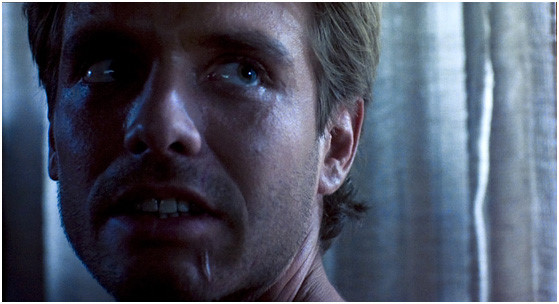 |
|
|
|
|
Empathy : 9
The Terminator is a high voltage thriller on a budget (less than 10% of the sequel.) At times, the effects are about as convincing as animé. But once we get past the futuristic introductory material and the setting up and dispatching of the doomed roommate (which has uncomfortable tinges of a garden variety slasher movie), Cameron and his cast rise to the occasion with intense action sequences and smart writing (Kyle: "Cyborgs don't feel pain. I do." Sarah: "Come on. Do I look like the mother of the future? I mean, am I tough, organized? I can't even balance my checkbook.") The Blu-ray manages to reproduce the dated quality of the production without making me ache for more. I am led to believe I am seeing this movie in as good a transfer as I ever shall, so I sit back and enjoy the ride.
Audio & Music : 6/7
I found the audio to be rather flat and, compared to other thrillers or adventure films of the day, uninvolving. We would expect this from bigger budget enterprises and directors who make audio a priority (e.g. Apocalypse Now or Cotton Club, but I was surprised to find that Repo Man, with a quarter of the budget, was clearer and much more dynamic. It is a tribute to just how effective the scenario and visuals are in The Terminator that the audio is not a liability.
Operations : 8
Loading and menu functions are straightforward; the chapters are indicated by small images that function as thumbnails, expanding to recognizable scenes when you select them, but are they not titled.
Extras : 7
Only one of the four "featurettes" from the R1 SD "Ultimate Edition" is included here - the one about creating the visual effects and music. But for reasons passing understanding, the complete "Other Voices" documentary from MGM's first Special Edition is not included here. The vintage interview with Cameron and Schwarzenegger is a hoot.
(SD Region 1 NTSC LEFT vs. Blu-ray Region A/1 RIGHT)
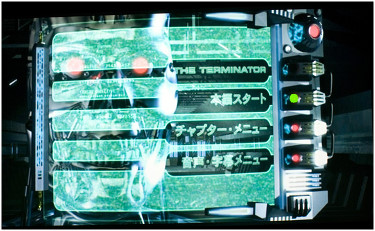 |
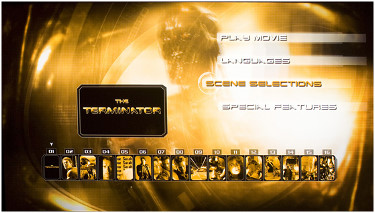 |
![]()
Terminator 2: Judgment Day
The Score Card
The Movie : 6
The Terminator is back, and he's almost human. His mission is protect the now adolescent John Connor from an even more indestructible Terminator - played by Robert Patrick with relentless intensity, though little of Arnold's menace. If it weren't for the bodies he indiscriminately leaves in his wake, Patrick's T-1000 would have more in common with Malkovich's Mitch Leary from In the Line of Fire than with Schwarzenegger's Terminator. But that's just one of the many ways Cameron made sure the audience would not come to feel that the sequel was merely a warmed over version of the original. Sarah Connor (again played by Linda Hamilton, now buff and brooding) is in a prison hospital for the criminally insane. She suffers from apocalyptic delusions and wants desperately to see her son. Dr. Silberman thinks she's too dangerous even for that, and would only try to make another escape. He's not wrong. Edward Furlong, at 14, certainly looked the part of Sarah's son, but I found him at times a little self-conscious (and who wouldn't be in such company in their first screen role), though in key moments he was just what Cameron and we needed.
Image : 9
Going up against the SD "Ultimate" and "Extreme" editions (I liked the Extreme's metal box, even though the Ultimate's image was a bit cleaner), the new Blu-ray had to go some to make the upgrade worthwhile. I'd give it about 1.5 points (out of 10) better than the Ultimate and 2 better than the Extreme. Of course, if you like the movie, there is no question: I can't imagine a theatrical presentation better than what I see on my 100 inch screen. The only downside to the BD is that it reveals the shortcomings of the original film in terms of film stock, lighting, photography and production design. The movie itself doesn't seem to have a consistent approach to image, and the result is more apparent on high definition video than in the theatre. The score of 9 might be generous, but I wanted to suggest that it isn't likely to be bettered on yet another high-def edition.
|
|
|
|
Empathy : 8.5
Except for the variations in image just noted, but supported by its superb audio track, I was right there all over again.
Audio & Music : 9/8
This is one disc that I wanted to audition in surround in addition to my clear and dynamic, but otherwise straight ahead, two-channel set-up at home. And, no surprise, T2 benefits from the extra weight that a good system can reveal. There isn't all that much dialog that matters in the big action scenes, so I didn't miss that level of clarity that I get at home. But it was nice to have those action pans in all the right directions to help create the extra thrill. Brad Fiedel's percussive, metallic score – much more dynamic in terms of orchestration and realization than the first movie - added a familiar punch, and the surround contributed the necessary weight.
Operations : 6
The Menu took some getting used to in order to navigate. It reminded me of the SD Limited Edition of Memento and how much I just wanted to get on with it rather than play a video game at just this moment.
Extras : 7
There are two selectable commentary tracks, accessible while the film is running. One is with the director and his co-writer, William Wisher. The other features "26 members of the cast and crew" which is bloody entertaining as well as informative. Curiously there are no video extras at all.
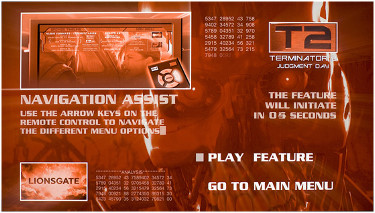 |
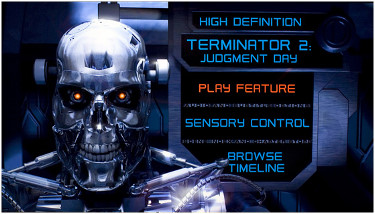 |
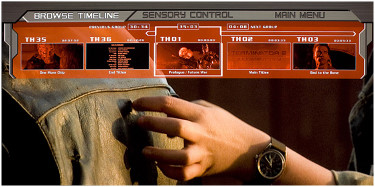 |
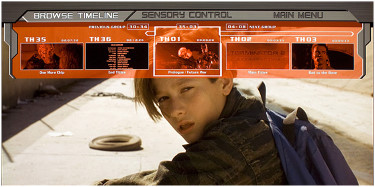 |
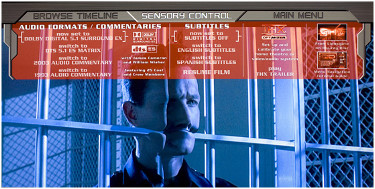 |
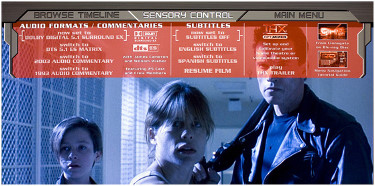 |
Leonard Norwitz
LensViews
July 15th, 2007
COMING SOON:
The Queen
Unforgiven
Casino Royale
Enter the Dragon
Kung-Fu Hustle
Rocky
Reds
